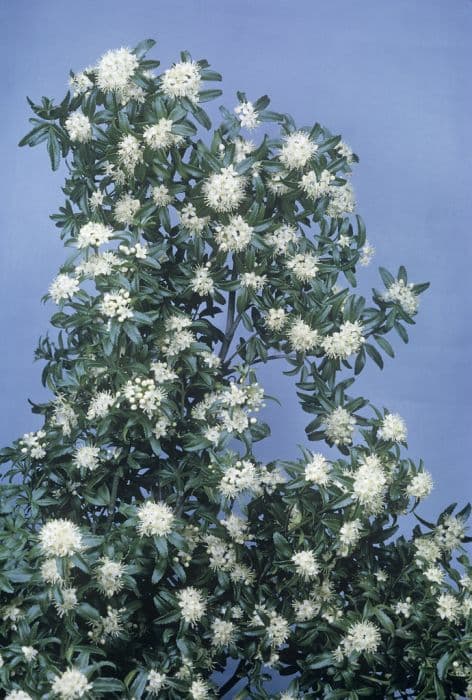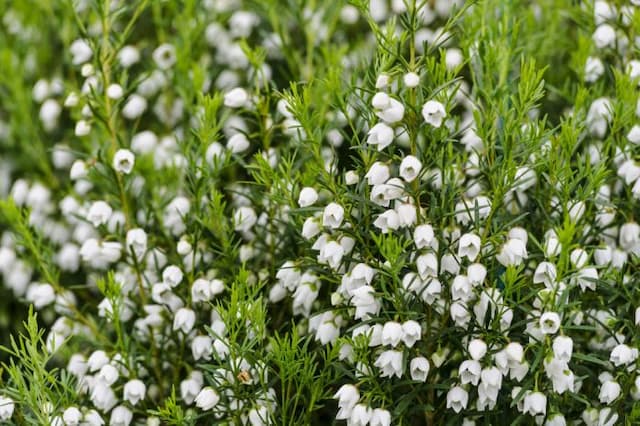Wafer Ash Ptelea trifoliata

ABOUT
The common name for Ptelea trifoliata is Hoptree or Wafer Ash. This plant is characterized by its compound leaves which typically consist of three broad, glossy leaflets with a somewhat rounded shape. The leaflets are arranged in a symmetrical fashion, giving the plant its trifoliate name, meaning "three-leaved." The foliage is often described as emitting a citrus-like fragrance when crushed. The Hoptree produces tiny, inconspicuous greenish-white flowers, which are arranged in clusters. These blooms are not particularly showy and might easily go unnoticed. After the flowering period, the plant develops distinctive papery, wafer-like seed pods which are somewhat circular, flattened, and hang in clusters. These light tan to brown seed pods persist through the winter and can add visual interest to the plant when most other deciduous trees and shrubs have lost their leaves. Bark on the Hoptree is relatively smooth with a grayish-brown color, but it may become more ridged and furrowed as the plant matures. The overall shape of the plant is irregular, tending towards a more open and spreading form that can make it an attractive addition to landscape designs where a naturalistic appearance is desired.
About this plant
 Names
NamesFamily
Rutaceae.
Synonyms
Hop Tree, Wafer Ash, Hoptree, Stinking Ash, Skunk Bush, Three-leaved Hop.
Common names
Ptelea crenulata, Ptelea crenulata var. angustifolia, Ptelea crenulata var. tomentella, Ptelea crenulata var. typica, Ptelea trifoliata var. angustifolia, Ptelea trifoliata var. crenulata, Ptelea trifoliata var. mollis, Ptelea trifoliata var. platyptera.
 Toxicity
ToxicityTo humans
The common name for Ptelea trifoliata is Hoptree. Hoptree is not commonly known to be toxic to humans. However, it's always prudent to exercise caution and avoid ingesting plants or plant parts unless they are known to be safe as individual sensitivities can vary.
To pets
Hoptree is not commonly known to be toxic to pets. However, as with humans, it is best to prevent pets from ingesting plants that are not certified as safe for consumption, since individual animals might have different sensitivities or allergic reactions to certain plants.
 Characteristics
CharacteristicsLife cycle
Perennials
Foliage type
Deciduous
Color of leaves
Green
Flower color
Greenish
Height
10-25 feet (3-7.6 meters)
Spread
10-25 feet (3-7.6 meters)
Plant type
Tree
Hardiness zones
4-9
Native area
North America
Benefits
 General Benefits
General Benefits- Landscape Ornamentation: Ptelea trifoliata, commonly known as Wafer Ash or Hoptree, adds aesthetic value to landscaping with its attractive, trifoliate leaves and rounded shape.
- Wildlife Habitat: It provides shelter and food for various forms of wildlife, including birds and butterflies.
- Drought Resistance: Wafer Ash has good drought tolerance once established, making it suitable for xeriscaping or dry environments.
- Soil Adaptation: It can thrive in a variety of soil types, ranging from well-drained to clay soils, giving it a broad planting range.
- Windbreak: In rural settings, Wafer Ash can be used as part of a windbreak due to its sturdy nature and resilience to wind.
- Unique Fruit: The plant produces distinctive winged fruits, which can add visual interest during the late summer and autumn months.
- Shade Provider: Mature trees can provide a moderate amount of shade, making them useful in parks, gardens, or as street trees.
 Medical Properties
Medical Properties- Antirheumatic: Ptelea trifoliata, commonly known as Wafer Ash, has been traditionally used to treat rheumatism.
- Diuretic: The plant has been used to promote the production of urine, helping in the removal of excess water from the body.
- Tonic: It is considered to have a general tonic effect, potentially strengthening and invigorating the body.
- Stimulant: Wafer Ash has been used as a stimulant, potentially to increase or enhance bodily functions.
- Bitter Tonic: The bark of the plant possesses bitter qualities and has been used as a bitter tonic, which could help stimulate appetite and digestion.
- Febrifuge: The plant has been used for its febrifuge properties, meaning it was used to reduce fever.
 Air-purifying Qualities
Air-purifying QualitiesThis plant is not specifically known for air purifying qualities.
 Other Uses
Other Uses- Insect Repellent: Ptelea trifoliata, commonly known as hoptree, has been traditionally used to repel insects due to its strong, citrus-like odor which is unappealing to many insect species.
- Perfumery: The hoptree's oil can be used in making perfumes, providing a unique, aromatic citrus scent that serves as a fragrance base.
- Fishing Aid: Native Americans crushed the leaves of hoptree and mixed them with water to stun or kill fish, facilitating easier capture due to the plant's toxic compounds.
- Decorative Purpose: The hoptree's attractive trifoliate leaves and clusters of small greenish-white flowers can be used for ornamental purposes in gardens and floral arrangements.
- Dye Production: The bark of the hoptree can be used to create a natural dye, providing colors that range from yellow to green.
- Culinary Flavoring: The seeds of the hoptree have been used as a substitute for hops in brewing beer, imparting a bitter flavor.
- Landscaping: Hoptree is used in landscape design, particularly for native plant gardens and xeriscaping because it is drought-resistant and low-maintenance.
- Leather Treatment: The bark and leaves of hoptree can be used in the tanning process of leather to impart a specific quality or finish to the material.
- Photography: The juice of hoptree fruits, being acidic, can potentially be used in alternative photography processes as a natural mordant or developing agent.
- Environmental Indicator: The presence and health of hoptree populations can serve as an indicator of certain environmental conditions, such as soil quality and ecosystem integrity.
Interesting Facts
 Feng Shui
Feng ShuiThe Wafer Ash is not used in Feng Shui practice.
 Zodiac Sign Compitability
Zodiac Sign CompitabilityThe Wafer Ash is not used in astrology practice.
 Plant Symbolism
Plant Symbolism- Resilience: Ptelea trifoliata, also known as the Hop Tree, is known for its hardy nature and ability to thrive in various conditions, symbolizing the ability to withstand adversity.
- Adaptability: Due to its wide range of habitats, the Hop Tree represents adaptability and the capacity to prosper in diverse environments.
- Healing: The tree has been used in traditional medicine, especially by Native American tribes, representing healing and medicinal properties.
- Protection: The Hop Tree has been used to create natural barriers or hedges, symbolizing protection and the creation of safe boundaries.
 Water
WaterThe common hop tree should be watered regularly, especially during its establishment phase, to ensure a deep and extensive root system. Once established, this tree tolerates drought and requires less frequent watering. In the absence of rainfall, a weekly watering with approximately 1-1.5 gallons of water should suffice. During hot or dry spells, you may need to increase the frequency to twice a week, ensuring the soil remains moist but not waterlogged. As a general rule of thumb, aim for the soil to be consistently moist to a depth of about 10 inches.
 Light
LightThe common hop tree thrives best in full sun but can tolerate partial shade. It should be planted in a location that receives at least six hours of direct sunlight daily for optimal growth and development. However, it can still perform well in a spot that has dappled sunlight or light shade, especially in hotter climates.
 Temperature
TemperatureThe common hop tree can withstand a range of temperatures, generally faring well in USDA hardiness zones 4 through 9. It can survive minimum temperatures down to -30°F and is tolerant of high summer temperatures. The ideal temperature range for this tree is between 60°F to 80°F. It is adaptable to various conditions but may need protection from harsh frost when young.
 Pruning
PruningPruning the common hop tree is important to maintain its shape and remove any damaged or diseased branches. The best time to prune is in the late winter or early spring before new growth begins. Pruning can be done annually, focusing on thinning out crowded branches to allow light and air to penetrate the canopy, which encourages healthy growth.
 Cleaning
CleaningAs needed
 Soil
SoilThe Wafer Ash or Hop Tree prefers well-draining soil mixed with compost or peat moss to retain some moisture. Optimal soil pH for Ptelea trifoliata is neutral to slightly alkaline, ranging from 7.0 to 8.0. A combination of loam, sand, and silt with added organic matter will support its growth well.
 Repotting
RepottingWafer Ash trees do not require frequent repotting as they are typically grown outdoors. If grown in containers, young Hop Trees may need repotting every couple of years to accommodate root growth. Mature trees can be repotted less often, only when pot-bound.
 Humidity & Misting
Humidity & MistingThe Hop Tree, or Wafer Ash, is tolerant of a wide range of humidity levels. It does not have specific humidity requirements, making it an adaptable plant for various outdoor environments.
 Suitable locations
Suitable locationsIndoor
Use bright light, well-draining soil, and water when dry for indoor Hop Tree.
Outdoor
Plant in sun to part shade, mulch well, and water regularly for outdoor Hop Tree.
Hardiness zone
4-9 USDA
 Life cycle
Life cyclePtelea trifoliata, commonly known as common hoptree, begins its life cycle as a seed which, after dispersal, requires stratification to break dormancy. Upon favorable conditions such as sufficient moisture and temperature, the seed germinates and develops a taproot with initial leaves, known as seed leaves or cotyledons. The plant then enters the seedling stage, where true leaves develop and photosynthesis begins, allowing growth into a juvenile phase. As a perennial plant, the hoptree progresses to a mature phase characterized by the development of a woody stem, compound leaves, and a tree or shrubby form. It reaches reproductive maturity within a few years, producing clusters of small, greenish-white flowers which are followed by the distinctive, wafer-like, two-winged fruit. The hoptree completes its life cycle by dispersing seeds, either by wind or with the help of animals, before eventually senescing and dying, which can occur after many decades of growth in favorable conditions.
 Propogation
PropogationPropogation time
Spring-Early Summer
Ptelea trifoliata, commonly known as Hoptree, is typically propagated by seed. The most popular method for propagating Hoptree involves collecting seeds in the fall once they've ripened. After collection, the seeds require a period of cold stratification to break dormancy, which can be achieved by mixing the seeds with moist sand and refrigerating them at about 40 degrees Fahrenheit (4 degrees Celsius) for approximately 60 to 90 days. Upon completion of the cold stratification, seeds are sown in pots or a prepared seedbed in spring. It's important to plant the seeds at a depth of around 1/4 inch (about 6 millimeters) in well-drained soil. With regular watering and protection from intense sunlight, germination should occur, followed by gradual growth of the seedlings, which can later be transplanted to their final growth positions.


![Mexican orange [Sundance]](/_next/image?url=https%3A%2F%2Fplants-admin.emdemapps.com%2Fimages%2Fplants%2F%2Fimages%2F604b5381bcf0d.png&w=640&q=75)






